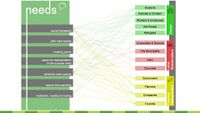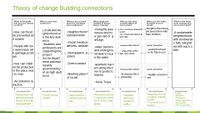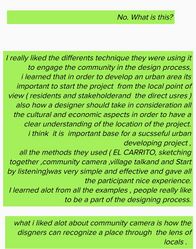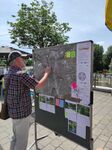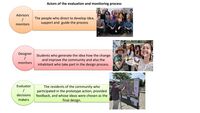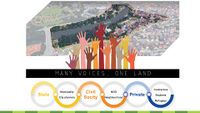LED2LEAP 2021 - Nürtingen Team 3: Difference between revisions
| (64 intermediate revisions by 3 users not shown) | |||
| Line 161: | Line 161: | ||
== Reflect on Your Story of Visioning == | == Reflect on Your Story of Visioning == | ||
<gallery caption=" " widths="200px" heights="150px" perrow="5"> | <gallery caption=" " widths="200px" heights="150px" perrow="5"> | ||
| Line 169: | Line 168: | ||
= Phase D: Collaborative Design, Transformation and Planning = | = Phase D: Collaborative Design, Transformation and Planning = | ||
== Your Prototyping Action== | == Your Prototyping Action== | ||
* | * | ||
Postcard for the community to have feedback from them and include it in our plan, | |||
Quiz to the community to draw the rivers in Nürtingen, | |||
Map to mark with green and orange flag that the green for the place they prefer to stay and the orange for the place they want to change in Nürtingen, with some pictures to write feedback on, | |||
Historical map to show how the river has changed, | |||
Facebook page to have more feedbacks. | |||
<gallery caption=" " widths="200px" heights="150px" perrow="5"> | <gallery caption=" " widths="200px" heights="150px" perrow="5"> | ||
File:1 postcarde.jpg|''Steinach River Postcard'' | File:1 postcarde.jpg|''Steinach River Postcard(front)'' | ||
File: | File:2 postcard.jpg|''Steinach River Postcard(back)'' | ||
File: | File:Neckar without river2.jpg|''Quiz for community'' | ||
File:Aa.png|''Historical map'' | |||
File:Ss.png|''Nurtingen map'' | |||
File:WhatsApp Image 2021-06-23 at 14.43.36.jpeg.jpg|''Facebook page'' | |||
</gallery> | </gallery> | ||
== The Evolution of Your Prototyping Action == | == The Evolution of Your Prototyping Action == | ||
During the COVID-19 Pandemic, it was impossible for all IMLA students to participate in this prototype action. For this, the students in Nürtingen work together with our university advisors to carry out this prototype action. | |||
As a Nürtingen team 3, we divided our prototype method into three phases. | |||
Phase 1: We created a postcard and distributed it to the prototype action participants (Nürtingen residents). | |||
Phase 2: We describe the process of this action to them and ask them to try it. | |||
Phase 3: We collect their feedback from the postcards and incorporate it into our final design. | |||
<gallery caption=" " widths="200px" heights="150px" perrow="5"> | <gallery caption=" " widths="200px" heights="150px" perrow="5"> | ||
File: | File:p_action.png|''Collaborative action process'' | ||
File: | File:Evaluations_.jpeg|'' solution from community '' | ||
File: | File:Collaborative action process 2.jpg|''community feedback'' | ||
File:WhatsApp Image 2021-07-05 at 12.17.54.jpeg|''community solution'' | |||
File:Community1234.jpg|''community feedback'' | |||
File:Involvment123.jpg|''community involvement'' | |||
File:Feedback.jpg|''community feedback'' | |||
</gallery> | </gallery> | ||
== The Plan Behind Your Prototyping Action == | == The Plan Behind Your Prototyping Action == | ||
Prototyping is an essential component in design to collect the user experience of a plan. It allows us to test our ideas and improve on them quickly. For our project, our plan is to involve the community throughout the process. Our plan was to guide them to identify their current problems, describe them about our design plan and asked their ideas for example what types of changes they want from us and then implement them through our action. | |||
<gallery caption=" " widths="200px" heights="150px" perrow="5"> | <gallery caption=" " widths="200px" heights="150px" perrow="5"> | ||
File: | File:Prototype-1.jpg|''Why prototype'' | ||
File: | File:1B.jpg|''Nürtingen map to collect data from the community'' | ||
File: | File:Describe.jpg|''Describe our purposes to the community'' | ||
File:Involveb.jpg|''Community involvement'' | |||
File:Behined.jpg|''Community involvement'' | |||
</gallery> | </gallery> | ||
== The Realization of Your Prototyping Action == | == The Realization of Your Prototyping Action == | ||
It was exciting to see the public participate in the prototype action. We were also unsure whether they would participate or not, and how we would manage to guide them given the small number of people present. However, our advisors assist us greatly throughout the entire process, and together we make it possible to collect feedback from the community. We can tell from community participation that people are concerned about the Steinach. They are bitterly disappointed and unhappy with the river's surrounding arrangement. They perceive it as a canal rather than a river. Furthermore, they want to see the Steinach as it once was. | |||
<gallery caption=" " widths="200px" heights="150px" perrow="5"> | <gallery caption=" " widths="200px" heights="150px" perrow="5"> | ||
File: | File:Flow2.png| ''Realization from prototype'' | ||
</gallery> | </gallery> | ||
== Reflect on Your Prototyping Action == | == Reflect on Your Prototyping Action == | ||
* | *prototyping action has allow us to reach community needs and concerning in the area that will be easer for us to do the planning process accordingly. community were exciting to help and give their suggestion in the places they prefer to stay in, and the places need to be fixed and how do they want to fix it, group has a bigger image in how to make the area fixed according to community needs. | ||
<gallery caption=" " widths="200px" heights="150px" perrow="5"> | <gallery caption=" " widths="200px" heights="150px" perrow="5"> | ||
File: | File:WhatsApp Image 2021-07-05 at 13.40.16.jpeg|''community draw same suggestion'' | ||
File: | File:WhatsApp Image 2021-07-05 at 13.39.09.jpeg|''River Quiz'' | ||
File:PlaceholderImage_17.jpg|''insert text here'' | File:PlaceholderImage_17.jpg|''insert text here'' | ||
</gallery> | </gallery> | ||
| Line 215: | Line 235: | ||
= Phase E: Collaborative Evaluation and Future Agendas = | = Phase E: Collaborative Evaluation and Future Agendas = | ||
== Collaborative Evaluation and Landscape Democracy Reflection == | == Collaborative Evaluation and Landscape Democracy Reflection == | ||
* | The process of how the different stakeholders take part in the monitoring process through out some games. Community put their suggestion in different areas that they prefer to stay in, and postcard was shared with community with two parts, the first one for them and the other one for their feedback and suggestion, that’s how we collected monitoring data from community. Moreover, evaluate the process together with the community. | ||
As for the further reflection on the process: There are two ways to assess if we have arrived at where we were meant to arrive: | |||
*The direct actions: by either including people in the media to give feedbacks on how the project is affecting them or doing some workshops to see how the people are reacting in the landscape evolution (First we arrange them and present for them what has been done. And we give them some pencils and stickers to write their ideas. and then we collect their ideas and see them. After that we give them a post card with an evaluation chart and see their satisfaction status). Or we can do both of them. | |||
*The indirect actions: By seeing the landscape if it's in a good shape than people are taking good care of it or/and If a lot of people are hanging by the Steinach more than before than that's a good sign. So having an intime analysis could be an evaluation process. | |||
<gallery caption=" " widths="200px" heights="150px" perrow="5"> | <gallery caption=" " widths="200px" heights="150px" perrow="5"> | ||
File: | File:0006.jpg|''Reflection on the prototype for community integration'' | ||
File: | File:0008.jpg|''Participation process'' | ||
File: | File:0009.jpg|''Postcard for further input on the project'' | ||
File:Group_3_-_Frame_5.jpg|''Further Evaluation of the project'' | |||
</gallery> | </gallery> | ||
== The Actors in your Collaborative Evaluation == | == The Actors in your Collaborative Evaluation == | ||
* | *Advisors/monitors:The people who direct to develop idea, support and guide the process. | ||
*Designer/monitors: Students who generate the idea how to change and improve the community and also the inhabitant who take part in the design process. | |||
*Evaluator/decisions makers: The residents of the community who participated in the prototype action, provided feedback, and whose ideas were chosen as the final design. | |||
I think it will be a great idea to integrate people who contributed in the first designing prototype part in the further evaluatif part because they know better how the landscape changed throughout the years. But we can always make use of the other ones because every idea helps somehow. | |||
<gallery caption=" " widths="200px" heights="150px" perrow="5"> | <gallery caption=" " widths="200px" heights="150px" perrow="5"> | ||
File: | File:0005.jpg|''The general impactful actors in the design process'' | ||
File: | File:0004.jpg|''The general actors of the prototype and further evaluation process '' | ||
</gallery> | </gallery> | ||
== Reflection on the Online Seminar == | == Reflection on the Online Seminar == | ||
* | * The seminar procedure greatly assists us in learning many new things.For example, knowing the theory first and then applying it to the project. | ||
* This course provides us with the opportunity to learn about some fascinating topics such as landscape challenges, community involvement, landscape rights, and so on. | |||
* We performed tasks with other students and groups during this course. This provided us with the opportunity to learn from a variety of people. | |||
* This seminar introduced us to some design methods such as collaborative design and prototyping, which were extremely useful for our other projects as well. Though it was not possible for all of us to participate in the active prototype action during the pandemic, we have done so here with our moderator, who assists us in running the process. | |||
*Finally, despite the assignment pressure, we can say that the course was interesting because of the tutors' interesting presentations and our participation through polling. We can say that we learned some topics that we can apply in our future work. | |||
== Reflection on the Living Lab Process == | == Reflection on the Living Lab Process == | ||
* | *Through the various assignments, we became acquainted with various actors and people in the landscape who have a significant impact on a project. | ||
*Aside from knowing the actors, we now have a better understanding of the stakeholders and the various characteristics of the landscape. | |||
*We learned about the process of public participation from our final prototyping action. Real prototyping was extremely beneficial to our project in terms of gathering people's ideas, which we incorporated into our design process. | |||
== Your Living Lab Code of Conduct == | == Your Living Lab Code of Conduct == | ||
* | *The spatial planning and design efforts that come from the lab are the result of bringing citizens into the researching of their community, analysis of the results, and carrying that understanding forward into a community vision with achievable goals and measurable results. We also are trying to implement the SDGs in our proposed solutions, because by thinking of our environment that we get a sustainable development. | ||
<gallery caption=" " widths="200px" heights="150px" perrow="5"> | <gallery caption=" " widths="200px" heights="150px" perrow="5"> | ||
File: | File:0009214.jpg|''Our shared goal for the landscape design'' | ||
File: | File:Diapositive7.JPG|''Bringing people together for one voiced solution'' | ||
</gallery> | </gallery> | ||
== Process Reflection == | == Process Reflection == | ||
* | *Quote: ‘’Democracy is not just a question of having a vote. It consists of strengthening each citizen’s possibility and capacity to participate in the deliberations involved in life in society.” -Fernando Cardoso. With this quote we can understand that our role as designers could be or should be involving the community in the process as a way of enhancing the quality of life for them. So the question to be asked is how can we make sure that we succeeded in our quest. | ||
*A good indicator of our challenge would be the involvement of locals in the design process of the landscape in Nürtingen. The impact of the process of involvment should be the last indicator because it comes at the very end after we finish the design and locals will give their final feedback on the project. Finally, the appreciation of the involvement process because then we know that the community is interested in what’s happening around them which make them more powerful towards the liberty of choice. | |||
*The main challenges we could face in this matter are: The different cultural backgrounds of each members, it could sometimes lead to conflicts which could create chaos, language barrier because we need to include even people who are coming from abroad, The choice of the proper evaluation method, Decision made from the evaluation could be confusing because many complex intervenants are onsight. | |||
Thanks to this process, we got to understand first what people really needed to see in their landscape. So we didn’t waste much time trying to figure out how we should design it. Also, we got to interact with the community better so we created new friends in the process. We also could resolve conflicts when it comes to putting all the ideas together and then again it’s tricky this part. We also now understand more how the community is linked to its habitat which makes a new knowledge in pocket. | |||
*Last but not least, our main role as architects, landscape architects or urban planners is to satisfy our clients and when it comes to our clients which are mostly communities a great way to communicate with them is by asking for their feedbacks constantly. I think without Democracy we can’t even think of something like that and who is going to visit these artefacts and if the locals disagree with what has been done who is going to stop the conflict then. We can look at democracy as a new way to resolve problems and a tool to strengthening people so that we can give them hope in life. | |||
Latest revision as of 00:33, 21 July 2021
>>>back to working groups overview
For help with editing this Wiki page use this link.
For assignments and key readings use this link.
Landscape Democracy Rationale
- Nürtingen is a town in the district of Esslingen in the German state of Baden-Württemberg.
- The area we sought as an important project site is the central part of the city of Nürtingen. The main reason is because this part is where many families assemble to have fun. Also the area is characterised by the existance of urban settlements, a small forest, urban garden, some commercial areas, historical artefacts and a beer garden on the north side of the river.
Location and Scope
- The area we worked on is:
Phase A: Mapping Your Community
Welcome to Your Community and Their Landscape
- The community in discussion offers lots of green artefacts like the forest and small recreational landscapes in addition to the Neckar and Steinach rivers. In addition to that, we noticed some irregularities like: No direct connection to the bridge, less seating place in the park Near the riverbank, there is an unutilized landscape, the river embankment is not well developed.
Groups of Actors and Stakeholders in Your Community
- As for actors and stakeholders, we have: CITY PLANNERS; City Municipality; NGO; Students; Neighborhood People; Corona Virus; People from other Neighborhoods.
Relationships Between Your Actors and Groups
- As for relationship between the actors we have represented that in a map. in which we have simplified the interaction between these actors from the most important interactive actors to the less ones. So from the center to the outer layer.
Theory Reflection
- The reading part of "Council of Europe Landscape Convention Contribution to human rights, democracy and sustainable development": Participatory process needs funding due to the continuity of its process. It also includes a wide public in the process.
- The reading part of "Landscape culture, culturing landscape" is well explained in the second map 2.
- The reading part of "The European Landscape Convention (Florence, 2000)" is well explained in the second map 3.
References
- European Landscape Convention (Florence, 2000).
- Landscape Culture - Culturing Landscapes (Kühne, Bruns et al, 2015).
- Landscape Convention Contribution to human rights, democracy and sustainable development(Council of Europe, 2018).
Phase B: Democratic Landscape Analysis and Assessment
Ahmed Essounni and Abhishek Vekariya and Tiffany Liu Correspondence
Shabnaz Tabassum and Mai Laila Correspondence
Your Name and Partner's Name Correspondence
- ''insert text here''
Arbil Al-Kubati and Ali Elbanna Correspondence
- ''insert text here''
Your Name and Partner's Name Correspondence
- ''insert text here''
Phase C: Collaborative Visioning and Goal Setting
The Scene in Your Story of Visioning
We chose the central part of Nürtingen, which is the city's historical site. It is close to the Neckar River. Residential settlements are the ones that are more visible on this site. There are also schools, an urban garden, sports facilities, and a few retail stores, and the community is linked to the main road. The main issue with this community is that it is not well connected to the Neckar River. The challenges depicted in the figure below describe the problems of this selected.
The Actors in Your Story of Visioning
- The actors of this community are elder people, young people, kids, municipality, local authorities, and the migrant's people, who are the user of this selected landscape.
The Story of Visioning
Our goal will be to "save the snowman." We all know that snow makes us happy, and people get together to build a snowman. In this case, we use the metaphor of a snowman to connect with the community. Building snowmen bring people around each other. And, as a result of climate change, this snowman is no longer visible. Because of the less accessibility, the community is separated from the landscape facilities at the site we have chosen. Our plan is to improve landscape connectivity and connect it to the community. For this, we considered increasing green space and establishing pocket parks. Seating areas near the river, as well as bike path connectivity throughout the Neckar. We would like to connect with the community and involve them throughout this process to save the snowman.
Reflect on Your Story of Visioning
Phase D: Collaborative Design, Transformation and Planning
Your Prototyping Action
Postcard for the community to have feedback from them and include it in our plan, Quiz to the community to draw the rivers in Nürtingen, Map to mark with green and orange flag that the green for the place they prefer to stay and the orange for the place they want to change in Nürtingen, with some pictures to write feedback on, Historical map to show how the river has changed, Facebook page to have more feedbacks.
The Evolution of Your Prototyping Action
During the COVID-19 Pandemic, it was impossible for all IMLA students to participate in this prototype action. For this, the students in Nürtingen work together with our university advisors to carry out this prototype action.
As a Nürtingen team 3, we divided our prototype method into three phases.
Phase 1: We created a postcard and distributed it to the prototype action participants (Nürtingen residents).
Phase 2: We describe the process of this action to them and ask them to try it.
Phase 3: We collect their feedback from the postcards and incorporate it into our final design.
The Plan Behind Your Prototyping Action
Prototyping is an essential component in design to collect the user experience of a plan. It allows us to test our ideas and improve on them quickly. For our project, our plan is to involve the community throughout the process. Our plan was to guide them to identify their current problems, describe them about our design plan and asked their ideas for example what types of changes they want from us and then implement them through our action.
The Realization of Your Prototyping Action
It was exciting to see the public participate in the prototype action. We were also unsure whether they would participate or not, and how we would manage to guide them given the small number of people present. However, our advisors assist us greatly throughout the entire process, and together we make it possible to collect feedback from the community. We can tell from community participation that people are concerned about the Steinach. They are bitterly disappointed and unhappy with the river's surrounding arrangement. They perceive it as a canal rather than a river. Furthermore, they want to see the Steinach as it once was.
Reflect on Your Prototyping Action
- prototyping action has allow us to reach community needs and concerning in the area that will be easer for us to do the planning process accordingly. community were exciting to help and give their suggestion in the places they prefer to stay in, and the places need to be fixed and how do they want to fix it, group has a bigger image in how to make the area fixed according to community needs.
Phase E: Collaborative Evaluation and Future Agendas
Collaborative Evaluation and Landscape Democracy Reflection
The process of how the different stakeholders take part in the monitoring process through out some games. Community put their suggestion in different areas that they prefer to stay in, and postcard was shared with community with two parts, the first one for them and the other one for their feedback and suggestion, that’s how we collected monitoring data from community. Moreover, evaluate the process together with the community. As for the further reflection on the process: There are two ways to assess if we have arrived at where we were meant to arrive:
- The direct actions: by either including people in the media to give feedbacks on how the project is affecting them or doing some workshops to see how the people are reacting in the landscape evolution (First we arrange them and present for them what has been done. And we give them some pencils and stickers to write their ideas. and then we collect their ideas and see them. After that we give them a post card with an evaluation chart and see their satisfaction status). Or we can do both of them.
- The indirect actions: By seeing the landscape if it's in a good shape than people are taking good care of it or/and If a lot of people are hanging by the Steinach more than before than that's a good sign. So having an intime analysis could be an evaluation process.
The Actors in your Collaborative Evaluation
- Advisors/monitors:The people who direct to develop idea, support and guide the process.
- Designer/monitors: Students who generate the idea how to change and improve the community and also the inhabitant who take part in the design process.
- Evaluator/decisions makers: The residents of the community who participated in the prototype action, provided feedback, and whose ideas were chosen as the final design.
I think it will be a great idea to integrate people who contributed in the first designing prototype part in the further evaluatif part because they know better how the landscape changed throughout the years. But we can always make use of the other ones because every idea helps somehow.
Reflection on the Online Seminar
- The seminar procedure greatly assists us in learning many new things.For example, knowing the theory first and then applying it to the project.
- This course provides us with the opportunity to learn about some fascinating topics such as landscape challenges, community involvement, landscape rights, and so on.
- We performed tasks with other students and groups during this course. This provided us with the opportunity to learn from a variety of people.
- This seminar introduced us to some design methods such as collaborative design and prototyping, which were extremely useful for our other projects as well. Though it was not possible for all of us to participate in the active prototype action during the pandemic, we have done so here with our moderator, who assists us in running the process.
- Finally, despite the assignment pressure, we can say that the course was interesting because of the tutors' interesting presentations and our participation through polling. We can say that we learned some topics that we can apply in our future work.
Reflection on the Living Lab Process
- Through the various assignments, we became acquainted with various actors and people in the landscape who have a significant impact on a project.
- Aside from knowing the actors, we now have a better understanding of the stakeholders and the various characteristics of the landscape.
- We learned about the process of public participation from our final prototyping action. Real prototyping was extremely beneficial to our project in terms of gathering people's ideas, which we incorporated into our design process.
Your Living Lab Code of Conduct
- The spatial planning and design efforts that come from the lab are the result of bringing citizens into the researching of their community, analysis of the results, and carrying that understanding forward into a community vision with achievable goals and measurable results. We also are trying to implement the SDGs in our proposed solutions, because by thinking of our environment that we get a sustainable development.
Process Reflection
- Quote: ‘’Democracy is not just a question of having a vote. It consists of strengthening each citizen’s possibility and capacity to participate in the deliberations involved in life in society.” -Fernando Cardoso. With this quote we can understand that our role as designers could be or should be involving the community in the process as a way of enhancing the quality of life for them. So the question to be asked is how can we make sure that we succeeded in our quest.
- A good indicator of our challenge would be the involvement of locals in the design process of the landscape in Nürtingen. The impact of the process of involvment should be the last indicator because it comes at the very end after we finish the design and locals will give their final feedback on the project. Finally, the appreciation of the involvement process because then we know that the community is interested in what’s happening around them which make them more powerful towards the liberty of choice.
- The main challenges we could face in this matter are: The different cultural backgrounds of each members, it could sometimes lead to conflicts which could create chaos, language barrier because we need to include even people who are coming from abroad, The choice of the proper evaluation method, Decision made from the evaluation could be confusing because many complex intervenants are onsight.
Thanks to this process, we got to understand first what people really needed to see in their landscape. So we didn’t waste much time trying to figure out how we should design it. Also, we got to interact with the community better so we created new friends in the process. We also could resolve conflicts when it comes to putting all the ideas together and then again it’s tricky this part. We also now understand more how the community is linked to its habitat which makes a new knowledge in pocket.
- Last but not least, our main role as architects, landscape architects or urban planners is to satisfy our clients and when it comes to our clients which are mostly communities a great way to communicate with them is by asking for their feedbacks constantly. I think without Democracy we can’t even think of something like that and who is going to visit these artefacts and if the locals disagree with what has been done who is going to stop the conflict then. We can look at democracy as a new way to resolve problems and a tool to strengthening people so that we can give them hope in life.





